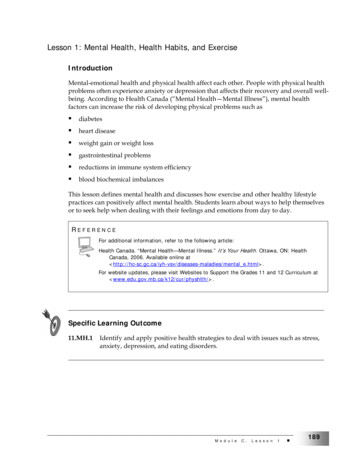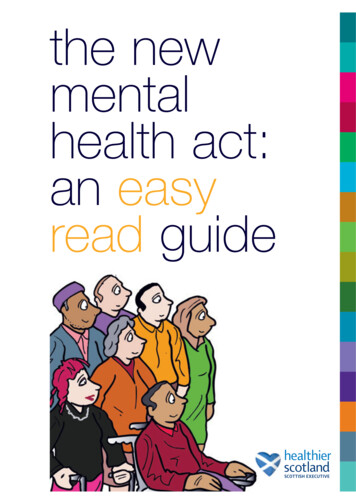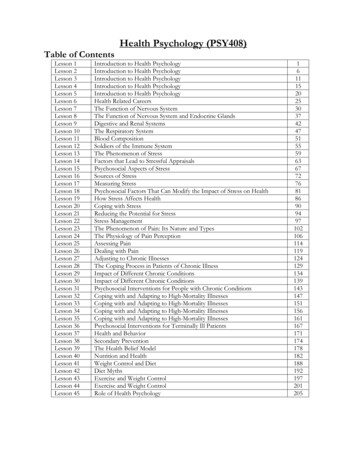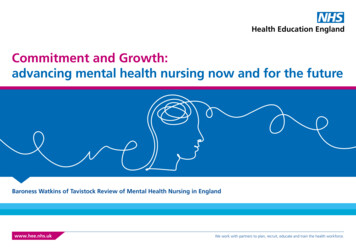
Transcription
Lesson 1: Mental Health, Health Habits, and ExerciseIntroductionMental-emotional health and physical health affect each other. People with physical healthproblems often experience anxiety or depression that affects their recovery and overall wellbeing. According to Health Canada (“Mental Health—Mental Illness”), mental healthfactors can increase the risk of developing physical problems such as diabetes heart disease weight gain or weight loss gastrointestinal problems reductions in immune system efficiency blood biochemical imbalancesThis lesson defines mental health and discusses how exercise and other healthy lifestylepractices can positively affect mental health. Students learn about ways to help themselvesor to seek help when dealing with their feelings and emotions from day to day.REFERENCEFor additional information, refer to the following article:Health Canada. “Mental Health—Mental Illness.” It’s Your Health. Ottawa, ON: HealthCanada, 2006. Available online at l e.html .For website updates, please visit Websites to Support the Grades 11 and 12 Curriculum at www.edu.gov.mb.ca/k12/cur/physhlth/ .Specific Learning Outcome11.MH.1Identify and apply positive health strategies to deal with issues such as stress,anxiety, depression, and eating disorders.M o d u l eC ,L e s s o n1 189
Key Understandings Mental-emotional health is a critical component of overall well-being. The stigma regarding mental-emotional health issues needs to be removed so thatpeople with mental health concerns engage in help-seeking behaviour. Healthy lifestyle practices support positive mental-emotional health.Essential Questions1. How is mental-emotional health different from mental illness?2. How do active lifestyle practices affect mental-emotional health issues (e.g., anxiety,depression, stress, eating disorders) and vice versa?Background InformationAs indicated by Health Canada (“Mental Health—Mental Illness”), most people will likelyexperience feelings of isolation, loneliness, sadness, stress, or disconnection from thingsduring their lifetime. These feelings are often short-term, normal reactions to difficultsituations, such as the death of a loved one, the loss of a job, a romantic breakup, or asudden change of circumstances. Learning to cope or deal with these “ups and downs” orthe good and bad times is part of life.What Is Mental or Emotional Health?Mental wellness, or good mental health, “isfeeling, thinking, and interacting in ways thathelp you enjoy life and deal effectively withdifficult situations” (Manitoba HealthySchools).Good mental health, more recently referred toas mental wellness, is not just the absence ofmental health problems. Although differentcultures have differing expectations for health,many of the following characteristics are likelyto be present in individuals with good mentalhealth in many cultures:DEFINITIONmental-emotional healthThe state or balance of a person’sthoughts, feelings, and actions. Mentalemotional health relates to how peoplelook at themselves, their lives, and theother people in their lives, how theyevaluate their challenges and problems,and how they explore choices. Thisincludes handling stress, relating to otherpeople, and making decisions. sense of well-being and satisfaction ability to enjoy life, to laugh, and to have fun ability to deal with life’s stresses and to bounce back from adversity190 G r a d e1 1A c t i v eH e a l t h yL i f e s t y l e s
participation in life to the fullest extent possible, through meaningful activities andpositive relationships capacity to change, grow, and experience a range of feelings, as life’s circumstanceschange sense of balance in own life between solitude and sociability, work and play, sleep andwakefulness, rest and exercise, and so on self-care that attends to the needs of the whole person—mind, body, spirit, creativity,intellectual development, health, and so on ability to care for others self-confidence and good self-esteemWhy Is Mental-Emotional Health Important?Our minds are not separate entities from the rest of us. Whenwe are distressed, our physical health is also affectednegatively, and our spirits decline. Many physical conditionsare actually rooted in a state of mind (psychosomatic illness),or in a history of stress that has never been balanced. Hence itis important to take care of the body, mind, and spirit.“Mens sana in corporesano (a healthy mind in ahealthy body)”—Juvenal (Roman poet)What Is Mental Illness?Mental illness, by definition, is quite different from everyday feelings and reactions todifficult situations. People who suffer from a mental illness may experience a seriousdisturbance in thinking, mood, or behaviour, which may have an impact on their ability tofunction effectively over a long period of time. Mental illness may affect people’s ability tocope with the simplest aspects of everyday life. Many people need help in regaining balancein their lives.Healthy Lifestyle PracticesExamining healthy lifestyle practices orcoping mechanisms to deal with everydayliving is an important part of developingmental-emotional health. The engagementin healthy lifestyle practices contributes toboth the quality and duration of life. Thehealth habits or healthy lifestyle practicesexplored in the following Suggestions forInstruction/Assessment can significantlyaffect a person’s life.DEFINITIONhealthy lifestyle practicesAny behaviour that has an effect on aperson’s health and well-being. (The levelor amount of the behaviour engaged in willdetermine the degree of the positiveeffect.)M o d u l eC ,L e s s o n1 191
REFERENCESFor information on mental and emotional health, refer to the following websites:Health Canada. “Mental Health—Mental Illness.” It’s Your Health. Ottawa, ON: HealthCanada, 2006. Available online at l e.html .Helpguide. “Mental and Emotional Health.” www.helpguide.org/mental/mental emotional health.htm .Manitoba Healthy Schools. “Mental Health: What Is Mental Wellness?” Mental Health. www.gov.mb.ca/healthyschools/issues/mental.html .For website updates, please visit Websites to Support the Grades 11 and 12 Curriculum at www.edu.gov.mb.ca/k12/cur/physhlth/ .Suggestion for Instruction / Assessment10 Basic Health HabitsUsing the active learning strategy Think-Pair-Share (see Appendix E), have students thinkof 10 basic health habits individually. Students then work in pairs to share their ideas and tocheck for similarities and differences. Two pairs then join to form a small group of four todevelop consensus on 10 basic health habits as a group.To help guide the group discussion, encourage students to include health habits related to physical activity (see Public Health Agency of Canada, Canada’s Physical Activity Guide toHealthy Active Living) healthy eating (see Health Canada, Eating Well with Canada’s Food Guide) sleep substance use, including tobacco and alcohol body weight personal and dental hygiene stress building healthy relationships general safetyStudents could also develop an advertising campaign promoting one or more health habit(s)using different media.192 G r a d e1 1A c t i v eH e a l t h yL i f e s t y l e s
REFERENCESFor additional information on basic health habits, refer to the following article:Zamora, Dulce. “13 Health Habits to Improve Your Life.” WebMD—Features Related toHealth and Balance. 2004. o-improve-your-life .The following guides are available online:Health Canada. Eating Well with Canada’s Food Guide. 2007. www.hc-sc.gc.ca/fn-an/food-guide-aliment/index e.html .---. Eating Well with Canada’s Food Guide: First Nations, Inuit and Métis. 2007. www.hc-sc.gc.ca/fn-an/food-guide-aliment/index e.html .Public Health Agency of Canada. Canada’s Physical Activity Guide for Youth. 2002. www.phac-aspc.gc.ca/pau-uap/fitness/downloads.html .---. Canada’s Physical Activity Guide to Healthy Active Living. 2004. www.phac-aspc.gc.ca/pau-uap/fitness/downloads.html .For website updates, please visit Websites to Support the Grades 11 and 12 Curriculum at www.edu.gov.mb.ca/k12/cur/physhlth/ .Suggestion for Instruction/AssessmentInfluences on Mental-Emotional HealthProvide each student with a copy of RM 1–MH (with the Mental Health Benefits left blank).Using the Think-Pair-Share strategy again, ask each student to identify and record mentalhealth benefits of healthy lifestyle practices on RM 1–MH. After students have completedthe task individually, they work with a partner to expand their list of benefits. Finally,students form small groups to share all the mental health benefits they have identified.Have each group present their top 10 mental health benefits.Refer to RM 1–MH: Influences on Mental-Emotional Health.REFERENCEFor additional information, refer to the following article:Nieman, David C. “The Health Continuum.” The Exercise-Health Connection. Champaign, IL:Human Kinetics, 1998. 5.M o d u l eC ,L e s s o n1 193
Background InformationEffect of Exercise on Mental HealthAs a result of exercise, the body releases different chemicals that affect the brain. One groupof chemicals is called endorphins. During exercise, the release of the beta-endorphin by thepituitary gland increases and produces an analgesic effect on the body as well as a feeling ofelation or euphoria.In his article “Exercise is a State of Mind,” Miller states that “for several decades we’veknown about one effect of exercise on the brain, the ‘endorphin high’ that makes us feelgood during and right after exercise” (48). He goes on to say that more recent scientists havediscovered some longer-lasting effects of exercise on the brain, such as decreased anxiety reduced depression improved ability to cope with stress raised self-esteem improved mood improved sleep increased cognition (mental functions such as the ability to think, reason, andremember)With exercise, several biological changes occur that make nerve cells more active or increasethe ability of neurons to communicate with one another. The way this works is that theexercise fuels the body with blood, which carries energy and oxygen to the brain, which inturn tells the body to produce more proteins called neurotrophic factors or growth factors.These substances stimulate nerve cells to grow and connect with one another(neuroplasticity) or to develop new nerve cells (neurogenesis).The hippocampus, a seahorse-shaped region in the temporal lobe of the brain, is involved inregulating mood and storing memories. Studies have shown that “exercise caused anincrease in the production of neuropeptide Y (NPY) in the hippocampus . . . [and] inducedan increase in brain-derived neurotrophic factor (BDNF) in the same region. These twoproteins—NPY and BDNF—are important prerequisites for nerve growth and survival”(Miller 49). These proteins can be thought of as the “fertilizers” for the brain. BDNF is anatural substance that enhances cognition by boosting the ability of neurons tocommunicate with one another.194 G r a d e1 1A c t i v eH e a l t h yL i f e s t y l e s
The release of other chemicals such as serotonin, dopamine, norepinephrine, melatonin, andinsulin are also affected by exercise, which in turn can affect mental and emotional health.Because activities such as going for a walk or a run, shooting baskets, skateboarding,participating in a sport, or doing yard work can contribute to better functioning of the mindand the body, exercising is a healthy lifestyle practice for everyone to do every day.REFERENCEFor additional information, refer to the following article:Miller, Michael Craig. “Exercise is a State of Mind.” Newsweek 149.13 (26 Mar. 2007):48–50, 52, 55.Suggestion for Instruction / AssessmentHealthy Lifestyle Practices for Mental-Emotional HealthHave students describe, by completing the chart in RM 2–MH, how healthy lifestylepractices (health habits) affect selected mental-emotional health issues.Refer to RM 2–MH: Healthy Lifestyle Practices for Mental-Emotional Health.After students have completed the chart, lead a class discussion on questions such as thefollowing: How do the identified lifestyle practices affect mental-emotional health? How does mental-emotional health affect lifestyle practices? Which lifestyle practice has the greatest impact on mental-emotional health, and why?Background InformationIs It Important to Seek Help for Mental-Emotional Problems?People encounter stressful situations that could range from minor to major on a day-today basis. Depending on the circumstances, individuals may need to seek help if theirreaction to stressors (e.g., loss, conflict, illness) becomes long term or interferes with otheraspects of life.Most people who experience mental health problems can overcome them or learn to livewith them, especially if they seek help from a qualified source soon enough. Althoughpeople usually do not hesitate to seek medical advice for a physical problem, some believeit is shameful or a sign of weakness to seek help for an emotional health problem. There isM o d u l eC ,L e s s o n1 195
often a stigma of weakness associated with seeking help when encountering a mental oremotional health problem.Students need to be reminded that it is OK to seek help and should learn how to access helpfor mental-emotional problems when needed.REFERENCESFor information on getting help for a mental health problem, refer to the following website:Manitoba Healthy Schools. “Mental Health: Where Can I Go For Help?” Mental Health. www.gov.mb.ca/healthyschools/issues/mental.html .For website updates, please visit Websites to Support the Grades 11 and 12 Curriculum at www.edu.gov.mb.ca/k12/cur/physhlth/ .For information related to working with students on the thinking, feeling, behavioural cycle,refer to the following text:Vernon, Ann. Thinking, Feeling, Behaving: An Emotional Education Curriculum forAdolescents, Grades 7–12. Rev. ed. Champagne, IL: Research Press, 2006.What Increases the Risk of Mental-Emotional Health Problems?Mental health problems can be the result of many different kinds of experiences in aperson’s life, from early childhood to later life. These life experiences may relate to aperson’s environment, hereditary history, psychological factors, and/or sociological factors.People may or may not have control over these factors.Suggestion for Instruction / AssessmentLife Experiences Leading to Mental Health IssuesIn a class brainstorming session, have studentsidentify life experiences that they think could leadto mental health issues. Encourage students tothink of situations or factors over which they havecontrol and situations over which they have nocontrol.NOTETOTEACHERPlease indicate to students that issuesidentified in this learning activity are notrequired to be personal.Once the class has identified numerous life experiences, have students classify which situations they do not have control over (e.g., biochemical issues, family history) situations they can have some control over (e.g., by getting support, making goodchoices, or learning more about their situation)Some situations or factors may fit into both categories.196 G r a d e1 1A c t i v eH e a l t h yL i f e s t y l e s
Check student responses against the list provided in RM 3–MH and add to the list anyareas identified by students in the class discussion (for future reference). Review the list of things over which students have some control. Discuss ways theycan control a given situation. Reflect on the list of things over which students usually do not have control. Talkabout ways they can get support and improve their mental health outcomes even ifthey have experienced situations they could control.Refer to RM 3-MH: Life Experiences Leading to Mental Health Issues foradditional suggestions and/or information to support this learning strategy.Background InformationHelping OneselfEach of us must learn to deal with our own feelings and emotions from day to day. All lifeexperiences, whether positive or negative, are character building. The key is to developskills for coping and managing our feelings and emotions and to learn from allexperiences.Resilience is the capability of an individual or group of individuals (such as a family, agroup of friends, or a community) to cope with significant adversity or stress in ways thatare not only effective, but also tend to result in an increased ability to respondconstructively to future adversity (Resiliency Canada). Research tells us that despitegrowing up in high-risk environments, the majority of young people not only becomesuccessful by societal standards, but also become self-confident, capable, and caringpersons. This is most often due to people’s ability to bounce back from challenging times(resiliency), to use self-help or self-care measures (healthy behaviour choices) to help themthrough, and to talk to someone who can offer support, as needed.Many minor mental health problems can be relieved by self-help or self-care measures. Ifwe are feeling “blue,” “out of sorts,” or “stressed out,” healthy lifestyle practices such asthe following can help us to feel better: Get enough rest and sleep. Eat a well-balanced diet. Avoid caffeine, alcohol, tobacco, or other drugs, and avoid mixing alcohol and drugs. Participate in physical activities. Do something that is enjoyable or relaxing (e.g., go to a funny movie, take a walk forenjoyment, listen to music, read a good book, talk to a friend, engage in an activity thatis safe and appealing).M o d u l eC ,L e s s o n1 197
Attend to spiritual needs (e.g., by meditating, visualizing, praying, appreciating abeautiful sunset). Make a list of the things that are troubling or causing tension, and then put away thelist for the rest of the day. Prioritize personal challenges and deal with the ones that are either most stressful oreasiest to check off the list. Spend ample time with people whose company is enjoyable, generally those who havea positive and respectful attitude. Talk to a trustworthy friend or family member about own feelings and concerns, anddiscuss possible reasons for those feelings. Ask them just to listen if advice is notdesired.If students continue to feel down, depressed, or anxious to the extent that these feelingsare interfering with school work or personal life (friends and family), they will need totalk to people who can help. School guidance counsellors can provide a safe place forstudents to share their feelings and develop problem-solving strategies for challengingsituations. Guidance counsellors also have connections to resources outside the school thatcan provide help.REFERENCESFor further suggestions on ways to develop and maintain positive mental and emotionalhealth, refer to the following websites:Health Canada. “Mental Health—Mental Illness.” It’s Your Health. 2006. l e.html .Helpguide.org. “Mental and Emotional Health.” Mental Health. www.helpguide.org/mental/mental emotional health.htm .Manitoba Healthy Schools. “Mental Health: What Is Mental Wellness?” Mental Health. www.gov.mb.ca/healthyschools/issues/mental.html .This site lists 10 tips for good mental health provided by the National Canadian MentalHealth Association.Resiliency Canada. “Understanding Resiliency.” www.resiliencycanada.ca/index.php?option com content&task view&id 17&Itemid 37 .For website updates, please visit Websites to Support the Grades 11 and 12 Curriculum at www.edu.gov.mb.ca/k12/cur/physhlth/ .198 G r a d e1 1A c t i v eH e a l t h yL i f e s t y l e s
RM 1–MH: Influences on Mental-Emotional Health*Mental HealthHow people HealthyRelationslook at themselves, theirlives, and the other peoplein their livesevaluate challenges andproblemsexplore voidingAlcoholand DrugsNoSmokingPhysicalActivityDentalHygieneMental HealthBenefitsContinued*Source: Adapted, with permission, from D. C. Nieman, 1998, The Exercise-Health Connection, (Champaign, IL: HumanKinetics), 5.M o d u l eC ,L e s s o n1 199
RM 1–MH: Influences on Mental-Emotional Health* (Continued)(Answer Key)Mental HealthHow people HealthyRelationslook at themselves, theirlives, and the other peoplein their livesevaluate challenges andproblemsexplore oSmokingImprovedSelf-esteemAvoidingAlcoholand ental ietyPositiveBody ImageImprovedResilienceReducedDepression*Source: Adapted, with permission, from D. C. Nieman, 1998, The Exercise-Health Connection, (Champaign, IL: Human Kinetics), 5.200 G r a d e1 1A c t i v eH e a l t h yL i f e s t y l e s
RM 2–MH: Healthy Lifestyle Practices for Mental-Emotional HealthComplete the chart below by providing a description of how the healthy lifestyle practices(health habits) from the first column affect one of the selected mental-emotional healthissues found along the top row (determined by the student). Place a plus sign ( ) in the corner of the box for a description that represents a positiveor beneficial effect. Place a minus sign (–) in the corner of the box for a description that represents anegative or detrimental effect. Place a zero (0) in the corner of the box for a description that could have both a positiveand a negative effect.Healthy LifestylePracticesMental-Emotional Health ()Physical ActivityHealthy EatingQuality SleepSubstance UseStress ManagementSmokingWeight ManagementPersonal SafetyDental HygieneHealthy RelationshipsM o d u l eC ,L e s s o n1 201
RM 3–MH: Life Experiences Leading to Mental Health IssuesThe following lists identify factors or situations that students usually do not have controlover and situations that students usually have some control over. Check student responsesagainst the lists provided below.Situations Students Usually Do Not Have Control OverLife experiences that may contribute to mental health issues that teenagers usually do nothave control over could include the following: Inheriting genetic causes. (People with a history of mental health problems in theirfamily may be more likely to develop problems themselves.) Experiencing biochemical causes. (An imbalance of neurotransmitters, such as serotonin,is known to affect the processing of thoughts and emotions.) Undergoing hormonal changes (that are a natural part of puberty and life transition) Having a low income or being homeless Living with a family member who has a mental illness or an addiction Experiencing violence, abuse, or other trauma Living in an environment that is chaotic, unsafe, or dangerous (e.g., living in a violenthome, or living in a house with shedding asbestos, peeling lead paint, or toxic drinkingwater, living in a community where drug use or gang violence is widespread) Experiencing chronic illnesses (whether born with or developed) Growing up in a homeland of unrest (e.g., witnessing or experiencing war, violence, orfear) Experiencing racism or other forms of prejudice (e.g., because of sexual orientation, age,religion, culture, class, body type) Dealing with the death of a family member or a close friend Experiencing a change in parental relationships (e.g., separation, divorce) Encountering a change in living environments (e.g., moving from one home to anotherdue to a change in parental relationship, foster home, job transition of a parent orguardian)Continued202 G r a d e1 1A c t i v eH e a l t h yL i f e s t y l e s
RM 3–MH: Life Experiences Leading to Mental Health Issues (Continued)Situations Students Usually Have Some Control OverLife experiences that may contribute to mental health issues that teenagers usually havesome control over could include the following: Using or abusing substances. (Alcohol and some drugs are known to have depressiveeffects or to increase anxiety. Some drugs such as crystal meth can cause symptoms thatresemble those of schizophrenia. The negative social and personal consequences ofsubstance abuse can also be a contributing factor to depression.) Using violence to solve problems (resulting in problems at home and/or at school andinvolvement in the justice system) Under-eating or overeating. (Restricting food intake below what the body needs oreating beyond comfort to cope with problems or difficult feelings can cause additionalmental and physical health problems.) Being in an unhealthy relationship. (The long-term toll of staying in an unhealthyrelationship or peer group is greater than the short-term turmoil and stress involved inleaving it.) Overdoing it by taking on too many things at one time to the point that it causesadditional stress (e.g., working too much while going to school, being involved in toomany activities) Not sleeping enough for what the body needs. (On its own, sleep deprivation will notcause a mental health problem, but when combined with other factors, including stress,insufficient sleep puts people at risk of poor health and a decreased coping capacity.)M o d u l eC ,L e s s o n1 203
190 Grade 11 Active Healthy Lifestyles Key Understandings Mental-emotional health is a critical component of overall well-being. The stigma regarding mental-emotional health issues needs to be removed so that people with mental health concerns engage in help-seeking behaviour. Healthy lifestyle practices support positive mental-emotional health.










